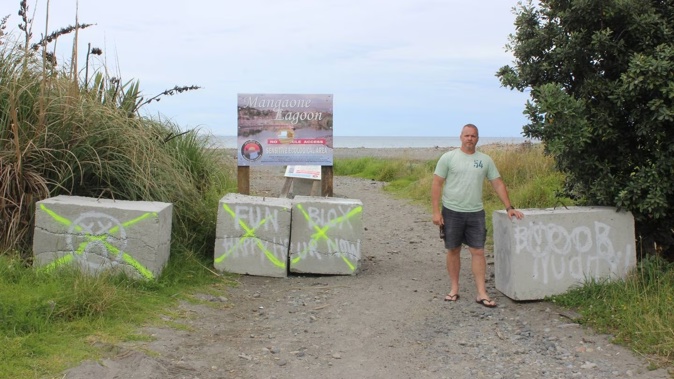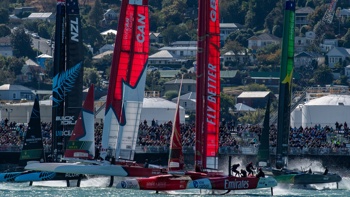
Five jumbo concrete blocks preventing vehicles from accessing a small public carpark at Te Horo Beach is causing frustration in some quarters.
The blocks were placed at the access entrance, which is on the corner of Te Horo Beach Rd and Rodney Ave, a few days before Christmas.
Kāpiti Coast District Council environment and ecological services team leader Andy McKay said the blocks were placed after the “repeated failure” of people to observe the rules prohibiting vehicles on the beach, especially around the ecologically sensitive Mangaone Stream mouth, which the carpark is adjacent to.
People could still park within 15 metres of the stream, just outside the blocks, and emergency services could still access the stream mouth from a short distance to the south, he said.
But local resident Brent Jarnell said there had been “an absolute lack of consultation” about the concrete blocks.
“They [the council] could have engaged with us, but they haven’t.”
He felt more information was needed.
“My request to the mayor, at this stage, is: get rid of the blocks and talk about it.
“Let’s do this the right way.”
Waikanae ward councillor Jocelyn Pravanov, in a social media interaction, said no barriers were intended after the beach bylaw review consultation, but there was expectation the community would adhere to the new bylaw.
“At the same time, there was also resounding feedback from the community that the rules of the bylaw had to be enforced.”
She didn’t know what had “precipitated the blocks going in now”, but she knew some people weren’t abiding by the bylaw, so it was now “tough love”.
Jarnell said the access had been there “for as long as anyone has known it”.
When there was a beach bylaw review, 62 per cent of people didn’t want the access blocked off, he said.
The southern access was more popular with motorists, while “it’s just the odd one which will come in here”.
A problem with the area is that some people used vehicles to cross the stream, which is against the beach bylaw, he said.
“There’s clear signage telling people not to do it – and most people don’t.”
Despite the new restriction, there were various other access areas nearby people could use that would enable them to drive over the stream, he said.
Signage in the area had been vandalised a few days after the blocks were installed, and someone had used a vehicle to pull one of the blocks away from the others.
The concrete block barrier at a small public carpark at Te Horo Beach. Photo / David Haxton
“I remember standing up, when barrier logs were put down the other end of the beach [in 2011], and [I said then that] if you don’t engage with the community, you end up with vandalised signs.”
Jarnell said the restricted access presented difficulties when stream maintenance was needed, stopped easy access to a water source if a fire needed to be fought, and added that the blocks were unsightly and went against the District Plan, where any beach work had to be in keeping with the environment.
He doubted there was an environmental issue as the “road has been the same as its always been”.
There are endangered dotterels in the area, but they generally kept to the other side of the stream, he said.
“There’s never been a dotterel run over.”
And while cars weren’t allowed to cross the stream, whitebait would easily dart away.
“A car tyre isn’t going to bother them.”
But others, including Friends of the Mangaone Lagoon, favoured vehicular restriction for various reasons.
Sue Chetwin, a local who spoke at the Waikanae Community Board’s November meeting, said while the area was described as a carpark, she had been advised by the council that it was a special ecological zone.
The area had enabled people to illegally drive vehicles past the carpark and onto the beach or over the stream.
While residents had complained about the illegal driving, “there’s really little that’s ever done about it”.
“So what happens is cars continue to access the beach and drive up and down it, when really, the area, including the carpark, should be there for the enjoyment of picnickers, kids, families, kayakers and [those participating in] other sorts of water-based activities,” she told the board.
“The irony is that because it’s accessed by vehicles, every time there’s a storm, the council comes and clears it so that vehicles can continue to access it, which is really expensive and unnecessary and probably also goes against the council’s plans to look at climate change and consider against inundation and flooding, because if there was limited access, and if the road wasn’t continually cleared for access to vehicles, then it would naturally build up [driftwood] and possibly provide some protection for houses against inundation and flooding.
“Then the council could actually consider some of the things it should be giving priority to, which is probably pollution in the stream.”
Vehicle restriction would allow wildlife (including endangered New Zealand dotterels) and plants to regenerate, she said.
And that would reduce vehicles crossing the stream, which “doesn’t help whitebait, I’m sure”.
Whitebaiters could park close by and still access the stream easily without parking on the beach, she added.
Having a “managed access barrier” would be a “really good outcome”.
“It would still allow people to access the stream, still allow them to enjoy all the beach activities, and allow the area to be the ecologically protected zone that it should be.”
Take your Radio, Podcasts and Music with you

/cloudfront-ap-southeast-2.images.arcpublishing.com/nzme/IHKEY54GQFFPJIBZOJ7MHGE5TE.JPG)








